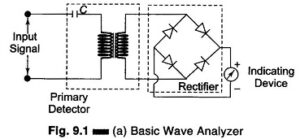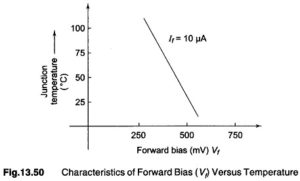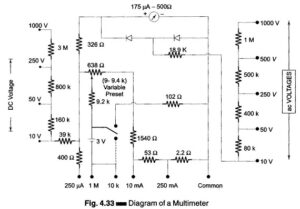Considerations in Choosing an Analog Voltmeter:
Considerations in Choosing an Analog Voltmeter has the following factors are to be considered.
1. Input Impedance
The input impedance or resistance of the voltmeter should be as high as possible. It should always be higher than the impedance of the circuit under measurement to avoid the loading effect, discussed in Section 4.6.
The shunt capacitance across the input terminals also determines the input impedance of the voltmeter. At higher frequencies the loading effect of the meter is noticeable, since the shunt capacitance reactance falls and the input shunt reduces the input impedance.
2. Voltage Ranges
The voltage ranges on the meter scale may be in a 1-3-10 sequence with 10 db separation or a 1.5-5-15 sequence or in a single scale calibrated in decibels. In any case, the scale division should be compatible with the accuracy of the instrument.
3. Decibels
For measurements covering a wide range of voltages, the use of the decibel scale can be very effective, e.g., in the frequency response curve of an amplifier, where the output voltage is measured as a function of the frequency of the applied input voltage.
4. Sensitivity v/s Bandwidth
Noise consists of unwanted frequencies. Since noise is a function of the bandwidth, a voltmeter with a narrow bandwidth picks up less noise than a large bandwidth voltmeter.
In general, an instrument with a bandwidth of 10 Hz-10 MHz has a sensitivity of 1 mV. Some voltmeters whose bandwidth extends up to 5 MHz may have a sensitivity of 100 μV.
5. Battery Operation
A voltmeter (VTVM) powered by an internal battery is essential for field work.
6. AC Current Measurements
Current Measurements can be made by a sensitive ac Voltmeter and a Series resistor
To summarize, the general guidelines are as follows.
- For dc measurement, select the meter with the widest capability meeting the requirements of the circuit.
- For ac measurements involving sine waves with less than 10% distortion, the average responding voltmeter is most sensitive and provides the best
- For high frequency measurement (> 10 MHz), the peak responding voltmeter with a diode probe input is best. Peak responding circuits are acceptable if inaccuracies caused by distortion in the input waveform are allowed (tolerated).
For measurements where it is important to find the effective power of waveforms that depart from the true sinusoidal form, the rms responding voltmeter is the appropriate choice.






